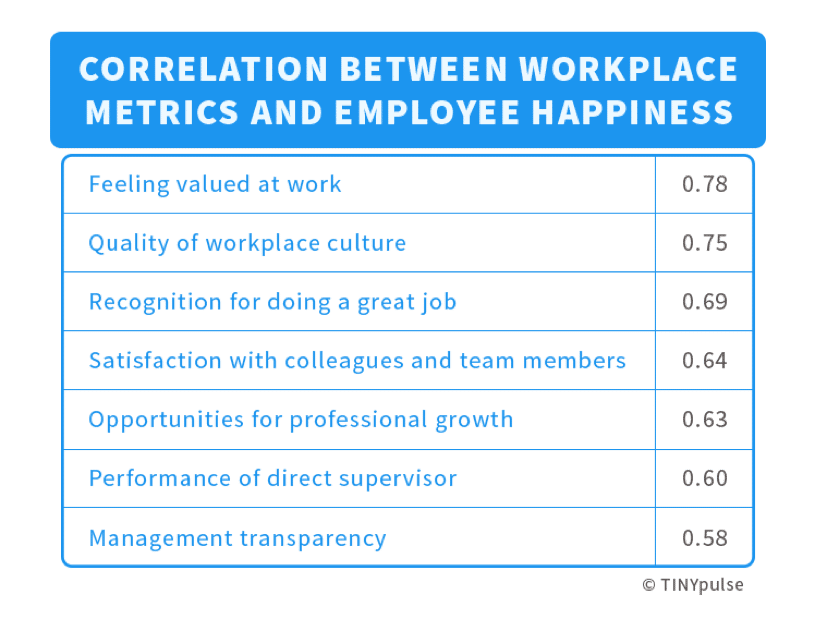The Top 4 Low-Cost Ways to Boost Employee Engagement

 This is a guest post by David Niu, CEO & Founder at TINYpulse. You can connect with David on Twitter @davidniu The best way to get the most out of your workforce is to make sure they’re engaged. According to the Temkin Group, 91% of highly engaged employees always or almost always try their hardest at work (among disengaged employees, only 67% say the same). But how do you know where to start with employee engagement? How do you figure out what makes employees more enthusiastic, invested, and inspired? One of the benefits of TINYpulse’s employee engagement survey is that we have access to a wealth of data about what employees think. With over 500 companies and thousands of employees telling us how they feel every week, we get to find out exactly what makes workers happy. Here are the top workplace factors that match up with high levels of happiness:
This is a guest post by David Niu, CEO & Founder at TINYpulse. You can connect with David on Twitter @davidniu The best way to get the most out of your workforce is to make sure they’re engaged. According to the Temkin Group, 91% of highly engaged employees always or almost always try their hardest at work (among disengaged employees, only 67% say the same). But how do you know where to start with employee engagement? How do you figure out what makes employees more enthusiastic, invested, and inspired? One of the benefits of TINYpulse’s employee engagement survey is that we have access to a wealth of data about what employees think. With over 500 companies and thousands of employees telling us how they feel every week, we get to find out exactly what makes workers happy. Here are the top workplace factors that match up with high levels of happiness:
This list should give you a plan of attack for improving employee engagement. And one of the best things is that you can work on these areas without breaking the bank. Start with these four strategies:
1. Say Thank You
Sincere, meaningful recognition doesn’t have to cost a dime. You don’t need to lavish employees with expensive gifts. It’s more important to take the time to recognize their individual talents and efforts. Announce their latest accomplishments at company meetings. Let them present the results of their big project to the senior leadership. Even if you do give them a treat, it doesn’t have to be a pricey one — an extra day off is free! And don’t just save recognition for the big moments. If you really want your employees to feel valued, then let them know you appreciate them every day. Better yet, get everyone participating. All employees, not just managers, see and appreciate what their coworkers do. Use a system like TINYpulse’s peer-to-peer employee recognition to make things easy.
2. Build a Great Culture
Culture and team go hand in hand. Your company’s culture is built every day by the actions and attitudes of your employees. So if you’ve got toxic employees, they’ll soon bring down the atmosphere around them. Decide what kind of culture you want — innovative and agile, built on collaboration, focused on customer service, etc. — and seek out candidates that can help you build it. Remember that skills can be taught. A person’s cultural fit is much harder to change.
3. Focus on Leadership
Happy employees have two qualities in their leaders: strong performance and transparency. To get the former, focus on leadership skills — not general job skills — when filling leadership roles. Just because an employee performs well in their job doesn’t necessarily mean they’ll perform well if you promote them to a managerial position. As for transparency? Open communication comes at no price. Establish regular channels for that communication, like all-hands meetings and one-on-ones between supervisors and their direct reports. Share important company information, like performance and quarterly goals. Announce major decisions and explain the context and reasoning. When employees know what’s going on, they’ll feel more involved and invested in the organization.
4. Help Them Develop
Finally, guide your employees on their path of professional growth. You can’t just focus on their current job duties and expect them to do the same thing forever. Find out what their interests are, and help them pursue those interests by giving them additional responsibilities at work or sponsoring additional training. (Yes, outside courses can cost money — but it’s an investment in skills and enthusiasm that will pay you back in spades.) If your employee wants to move up in the ranks, make the promotion process clear and accountable. And make sure you’ve supported their professional development so they’re prepared for the new role. These steps don’t take much in the way of resources, just effort. But that effort will benefit your company by helping you get a stronger team, a more positive work environment, a more invested workforce, and all the other benefits of high employee engagement.

